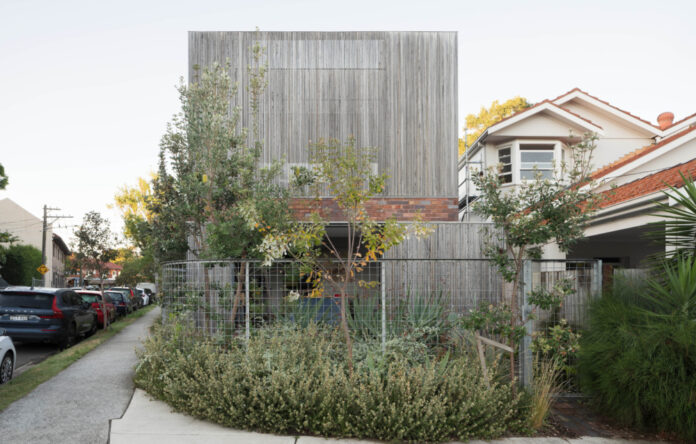[ad_1]
An Architect’s ‘Quietly Radical’ North Bondi Family Home
Architecture

Architect Anthony Gill’s own renovated family home in North Bondi. Photo – Clinton Weaver

Originally a small and dark single-storey with a closed off front courtyard, the renovation has opened up the home to the neighbourhood and improved its liveability in a sustainable and economical way. Photo – Clinton Weaver

Sue Barnsley designed the new outdoor areas that each reflect their specific orientation and exposure. Photo – Clinton Weaver

The minimal kitchen design was both budget driven and inspired by Anthony’s ‘soft spot’ for outdoor kitchens. Photo – Clinton Weaver

The ground floor has been cleverly reconfigured to allow for an open-plan kitchen, dining, and living area that seamlessly connects to the front garden. Photo – Clinton Weaver

Stairs leading to the new upper storey. Photo – Clinton Weaver

At night, the living room glows on otherwise dark streets as the predominant approach to living is challenged. Photo – Clinton Weaver

The new outdoor bathroom with an integrated undercover laundry off the main bedroom. Photo – Clinton Weaver

Photo – Clinton Weaver

The new upper storey features a defined lounge room. Photo – Clinton Weaver

The renovated main bathroom. Photo – Clinton Weaver

The reconfigured floorplan allowed for a third bedroom to be added. Photo – Clinton Weaver
Architect Anthony Gill describes the renovation of his own family home in North Bondi, Sydney as ‘quietly radical.’
Originally a small and dark single-storey with a closed off front courtyard, the renovation has opened up the home to the neighbourhood and improved its liveability in a sustainable and economical way.
Budget was a key driver of the project, dictating a restrained approach to the addition.
The surrounding streets—(described by Anthony as ‘a mix of apartment buildings and overdeveloped semis where front doors and rooms have been sacrificed for carports, and gardens reduced to the minimum’)—served as a lesson in what not to do.
Anthony and team redesigned the home with the front garden as the focal point to provide a ‘crucial filter’ between the house and the street. Fences and barriers were removed, increasing openings to the street for a generous connection between public and private.
‘It is abundant and generous, benefitting not only the inhabitants, but also the community,’ says Anthony.
Sue Barnsley designed the garden, in addition to three other outdoor areas surrounding the home, that each reflect their specific orientation and exposure.
A new upper storey was added, which features a defined lounge room opening to an outdoor bath/shower with an integrated undercover laundry.
Downstairs, the floorplan has been cleverly reconfigured to allow for a third bedroom and an open-plan kitchen, dining, and living area that seamlessly connects to the front garden.
The minimal kitchen design was both budget driven and inspired by Anthony’s ‘soft spot’ for outdoor kitchens.
At night, the living room glows on otherwise dark streets as the predominant approach to living is challenged.
The transformed house reflects Anthony’s values, providing a compelling case for modest, economical and sustainable development that simultaneously improves the lives of the inhabitants and community.
‘It challenges conventional ideas about room use and privacy to achieve an efficient and rich backdrop for life.’
[ad_2]
thedesignfiles.net










